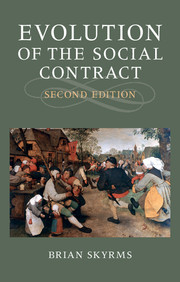Crossref Citations
This Book has been
cited by the following publications. This list is generated based on data provided by Crossref.
Laslier, Jean-François
2008.
Économie et cognition.
p.
245.
Hédoin, Cyril
2011.
J. McKenzie Alexander, The Structural Evolution of Morality.
OEconomia,
p.
472.
Hédoin, Cyril
2012.
Veblen et son actualité : sélection multi-niveaux et darwinisme généralisé.
OEconomia,
p.
179.
2015.
Books Received.
Philosophy,
Vol. 90,
Issue. 1,
p.
167.
Weaver, Russell
2015.
A Cross-Level Exploratory Analysis of “Neighborhood Effects” on Urban Behavior: An Evolutionary Perspective.
Social Sciences,
Vol. 4,
Issue. 4,
p.
1046.
KUHN, STEVEN
2016.
Gauthier and the Prisoner’s Dilemma.
Dialogue,
Vol. 55,
Issue. 4,
p.
659.
Santos, Fernando
Encarnação, Sara
Santos, Francisco
Portugali, Juval
and
Pacheco, Jorge
2016.
An Evolutionary Game Theoretic Approach to Multi-Sector Coordination and Self-Organization.
Entropy,
Vol. 18,
Issue. 4,
p.
152.
Encarnação, Sara
Santos, Fernando P.
Santos, Francisco C.
Blass, Vered
Pacheco, Jorge M.
and
Portugali, Juval
2016.
Paradigm shifts and the interplay between state, business and civil sectors.
Royal Society Open Science,
Vol. 3,
Issue. 12,
p.
160753.
Das, Abhimanyu
Gollapudi, Sreenivas
Kıcıman, Emre
and
Varol, Onur
2016.
Information dissemination in heterogeneous-intent networks.
p.
259.
Bhogal, Manpal Singh
Galbraith, Niall
and
Manktelow, Ken
2016.
Physical Attractiveness and Altruism in Two Modified Dictator Games.
Basic and Applied Social Psychology,
Vol. 38,
Issue. 4,
p.
212.
Santos, Fernando P.
Pacheco, Jorge M.
and
Santos, Francisco C.
2016.
Evolution of cooperation under indirect reciprocity and arbitrary exploration rates.
Scientific Reports,
Vol. 6,
Issue. 1,
Barceló, Juan A.
and
Del Castillo, Florencia
2016.
Simulating Prehistoric and Ancient Worlds.
p.
1.
Bench-Capon, Trevor
and
Modgil, Sanjay
2017.
Norms and value based reasoning: justifying compliance and violation.
Artificial Intelligence and Law,
Vol. 25,
Issue. 1,
p.
29.
Mosleh, Mohsen
and
Heydari, Babak
2017.
Fair Topologies: Community Structures and Network Hubs Drive Emergence of Fairness Norms.
Scientific Reports,
Vol. 7,
Issue. 1,
Vasconcelos, Vítor V.
Santos, Fernando P.
Santos, Francisco C.
and
Pacheco, Jorge M.
2017.
Stochastic Dynamics through Hierarchically Embedded Markov Chains.
Physical Review Letters,
Vol. 118,
Issue. 5,
Priel, Dan
2017.
The possibility of naturalistic jurisprudence.
Revus,
p.
7.
Mosleh, Mohsen
and
Heydari, Babak
2017.
Social Informatics.
Vol. 10539,
Issue. ,
p.
59.
Brennan, Thomas J.
Lo, Andrew W.
and
Zhang, Ruixun
2018.
Variety Is the Spice of Life: Irrational Behavior as Adaptation to Stochastic Environments.
Quarterly Journal of Finance,
Vol. 08,
Issue. 03,
p.
1850009.
Rahwan, Iyad
2018.
Society-in-the-loop: programming the algorithmic social contract.
Ethics and Information Technology,
Vol. 20,
Issue. 1,
p.
5.
Foley, Michael
Forber, Patrick
Smead, Rory
and
Riedl, Christoph
2018.
Conflict and convention in dynamic networks.
Journal of The Royal Society Interface,
Vol. 15,
Issue. 140,
p.
20170835.



